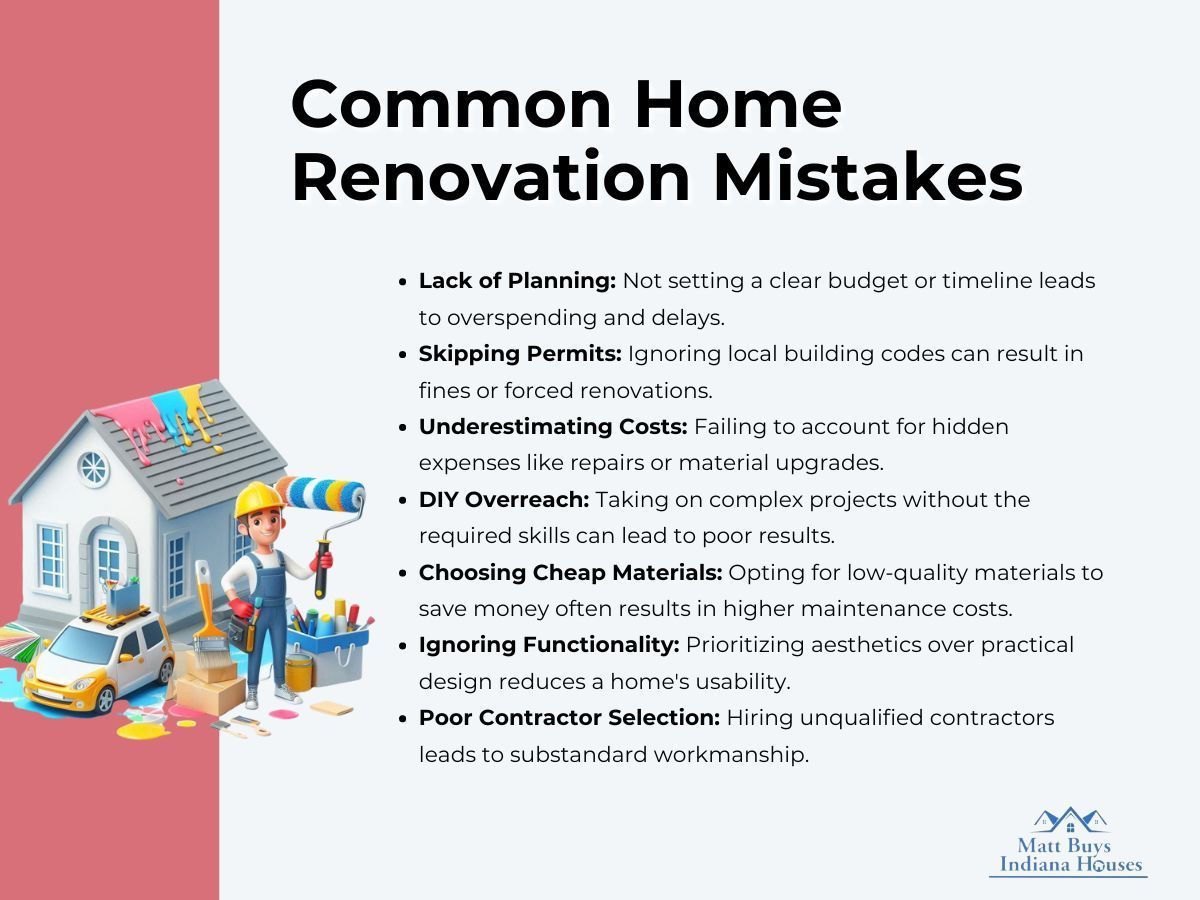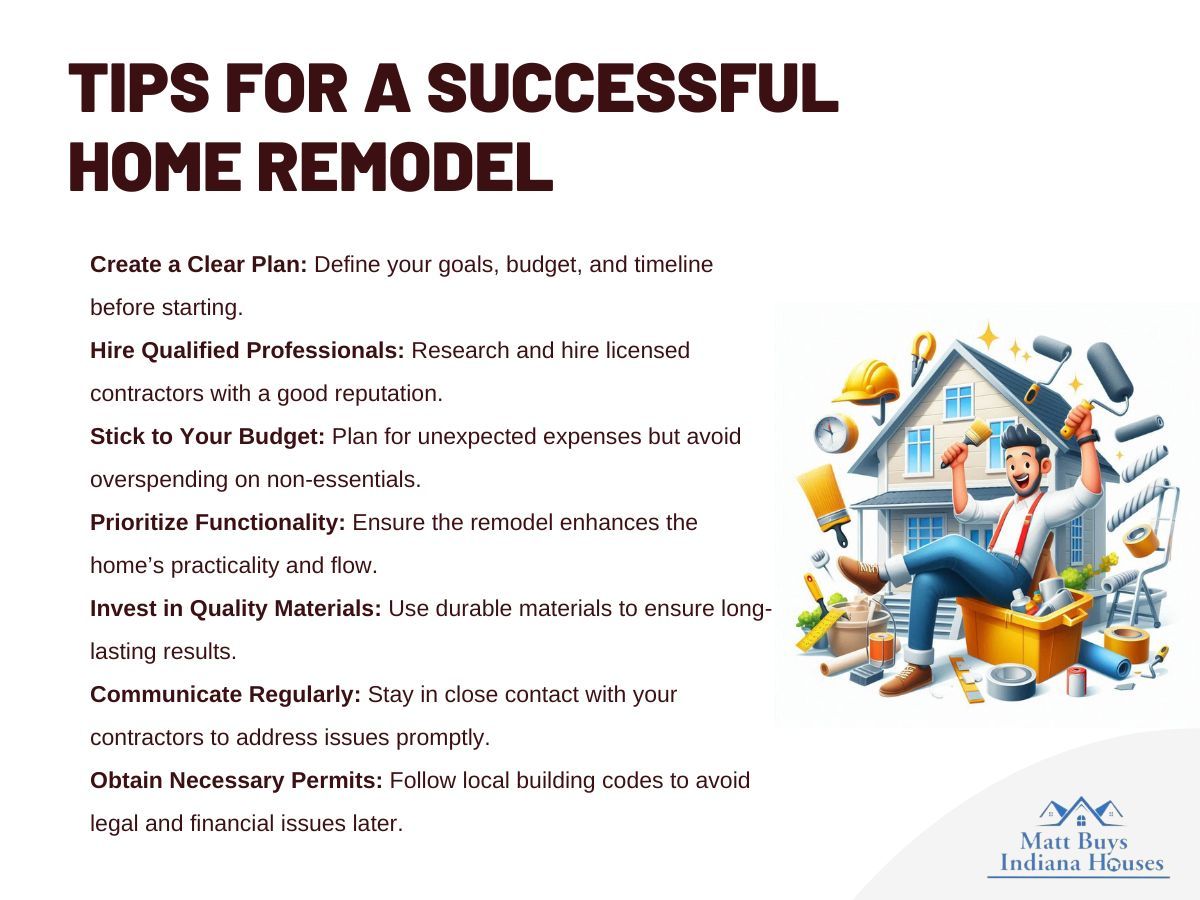Home Renovation Mistakes to Avoid: Tips for a Successful Remodel
August 31, 2024
Embarking on a home remodeling project can be both exciting and challenging. This article explores common mistakes to avoid, essential tips for a successful remodel, and additional advice to ensure a smooth process.
From planning and budgeting to choosing the right materials and managing disruptions, we’ll delve into strategies that will help you navigate your renovation with confidence and achieve the results you desire
Most Common Home Renovation Mistakes to Avoid
Home renovation projects can be exciting, but they also come with potential pitfalls that can lead to unexpected costs, delays, and dissatisfaction. Here are some common home renovation mistakes to avoid:

Skipping Detailed Planning
Starting a renovation without a comprehensive plan often leads to unexpected changes and delays. This can result in a final outcome that doesn't match your original vision and may cause frustration as the project progresses.
Underestimating Costs
Many homeowners fail to account for the full scope of renovation costs, often overlooking hidden expenses. This can lead to budget overruns, forcing compromises or leaving parts of the project unfinished.
Hiring the Wrong Contractor
Choosing a contractor based solely on cost or without proper research can backfire. It often results in poor workmanship, project delays, and increased costs, turning your renovation into a stressful experience.
Ignoring Necessary Permits
Failing to obtain the required permits before starting a renovation can lead to serious legal issues and fines. In some cases, you may even have to redo completed work, adding unnecessary time and expense to the project.
Poor Communication
Lack of clear communication between you and your contractor can lead to misunderstandings and mistakes. This often results in a finished product that doesn't meet your expectations, causing disappointment and potential conflicts.
Focusing Too Much on Trends
Overemphasizing trendy designs in your renovation can make your space look outdated quickly. While trends can be appealing, they might not have lasting appeal, which can diminish the long-term value of your home.
Neglecting Functionality
Prioritizing aesthetics over functionality can result in a space that looks great but doesn’t serve your everyday needs. This can make the renovated area impractical and frustrating to use over time.
Overlooking Structural Issues
Ignoring underlying structural problems during a renovation can lead to significant safety hazards and costly repairs later on. Addressing these issues early is crucial to avoiding bigger problems down the road.
DIYing Beyond Skill Level
Taking on DIY projects that exceed your skill level can result in poor-quality work and potential safety risks. This often necessitates hiring professionals to fix mistakes, costing more in the long run.
Neglecting Energy Efficiency
Overlooking energy-efficient options during a renovation can lead to higher utility bills and a less comfortable living environment. This mistake can also affect the long-term sustainability and value of your home.
Not Planning for Future Needs
Renovating without considering future changes, such as aging or family expansion, can limit the practicality of the space over time. This can result in the need for additional renovations sooner than anticipated.
Over-Personalizing the Space
Making design choices that are too specific to your tastes can make it harder to sell your home in the future. Potential buyers may find it difficult to envision themselves in a space that’s heavily customized.
Ignoring the Home’s Original Architecture
Renovating in a style that clashes with your home's original architecture can create a disjointed look. This can negatively impact the overall aesthetics and reduce the appeal and value of your home.
Starting Without a Clear Timeline
New ParagraphUnderestimating the time needed for a renovation often leads to delays and increased costs. This can disrupt your daily life more than expected and prolong the inconvenience of living in a construction zone.
Neglecting the Impact on Daily Life
Failing to consider how a renovation will affect your day-to-day living can lead to significant stress and disruptions. Without proper planning, the renovation process can become overwhelming and difficult to manage.
Avoiding these common mistakes will help ensure your home renovation project is a success, delivering the results you want on time and within budget.
Essential Tips for a Successful Home Remodel
A successful home remodel requires careful planning, clear communication, and a well-defined budget. Here are some key tips to ensure your project goes smoothly:

1. Create a Detailed Plan
Before starting your remodel, develop a comprehensive plan that outlines every aspect of the project. This should include your design vision, a realistic budget, and a clear timeline. Having a well-thought-out plan will guide the process and help prevent costly changes or delays.
2. Set a Realistic Budget
Establish a detailed budget that accounts for all expected costs, including materials, labor, and permits. It’s also wise to include a contingency fund of 10-20% for unexpected expenses that may arise during the project.
3. Hire the Right Professionals
Take the time to research and hire experienced, reputable contractors or designers who specialize in the type of remodel you're planning. Check references, read reviews, and verify their credentials to ensure they have a track record of delivering quality work on time and within budget.
4. Obtain Necessary Permits
Ensure you obtain all the required permits before beginning your remodel. This will not only keep your project legal but also ensure that the work meets
local building codes, which are crucial for safety and for maintaining your home's value.
5. Prioritize Communication
Maintain open and clear communication with your contractor or renovation team throughout the project. Regular updates, discussions, and documentation of decisions will help avoid misunderstandings and ensure everyone is on the same page.
6. Focus on Functionality
While aesthetics are important, it’s crucial to design your remodel with functionality in mind. Consider how the space will be used and ensure that it meets your practical needs. A balance between beauty and usability will make your renovation more satisfying in the long run.
7. Consider Future Needs
When planning your remodel, think about your future needs, such as aging in place or potential family expansion. Designing with flexibility in mind will make your home more adaptable and reduce the need for additional renovations later on.
8. Incorporate Energy Efficiency
Include energy-efficient features in your remodel, such as better insulation, energy-efficient windows, and appliances. These upgrades will not only reduce your utility bills but also make your home more comfortable and environmentally friendly.
9. Respect the Home’s Original Architecture
Ensure that the remodel complements your home’s original architecture. This will create a harmonious look and help preserve or even enhance the property’s overall value and appeal.
10. Stay Flexible and Patient
Remodeling can be unpredictable, with unexpected challenges often arising. Staying flexible and patient throughout the process will help you navigate any issues that come up, ensuring a smoother and more enjoyable experience.
11. Plan for the Impact on Daily Life
Consider how the remodel will affect your daily routine and plan accordingly. This might involve setting up temporary living arrangements or organizing your space to minimize disruption during construction.
12. Think Long-Term
Make design choices that are timeless and durable to ensure your remodel has lasting value. While trends can be fun to incorporate in small ways, focusing on classic designs and quality materials will make your home look great for years to come.
13. Monitor Progress
Regularly check in on the progress of the remodel to ensure it’s on track with your plan. Being proactive and involved allows you to address any issues early and keep the project moving forward smoothly.
14. Review Contracts Carefully
Before signing any contracts, review them thoroughly to understand the scope of work, payment schedules, and timelines. Clear contracts help avoid disputes and ensure that both parties are aligned on expectations.
15. Enjoy the Process
Finally, remember to enjoy the remodeling process! It’s an opportunity to create a space that reflects your personality and meets your needs, so take time to appreciate the journey and the final result.
By following these tips, you'll increase the chances of a smooth, successful home remodel that meets your expectations and adds
value to your property.
Additional Tips for a Successful Remodel
Here are some additional tips to ensure a successful home remodel:
- Prioritize Quality: Invest in high-quality materials for durability and fewer issues later.
- Involve the Whole Family: Get input from all household members to ensure the remodel meets everyone's needs.
- Stay Organized: Keep all project documents and receipts in order for efficient management.
- Plan for Storage: Incorporate ample storage solutions to keep your home clutter-free.
- Communicate with Neighbors: Inform them of any disruptions to maintain good relations.
- Test Materials and Colors: Check samples in your space before finalizing choices.
- Consider Resale Value: Choose designs that enhance your home’s value for future buyers.
- Focus on Lighting: Plan for both natural and artificial lighting to improve functionality and ambiance.
- Prepare for Maintenance: Select materials that are easy to clean and maintain.
- Expect the Unexpected: Be ready for surprises and adapt as needed.
- Enhance Curb Appeal: Update the exterior to boost your home’s attractiveness.
- Reflect Your Style: Blend personal taste with timeless elements for lasting appeal.
- Avoid Rushing Decisions: Take time to make thoughtful choices.
- Plan for Disruptions: Arrange for temporary adjustments to manage remodeling impacts.
- Celebrate Progress: Acknowledge milestones to stay motivated and appreciate the transformation.
These additional tips can help you manage your remodel more effectively and ensure that the end result aligns with your vision and needs.
Summary
This article is a comprehensive guide to a successful home remodel, starting with common pitfalls like inadequate planning and budget overruns. It provides essential tips for a smooth renovation, including choosing the right professionals and balancing aesthetics with functionality.
Additionally, it offers advice on maintaining quality, preparing for future needs, and managing disruptions to ensure a stress-free process and a final result that enhances your home’s beauty and functionality.











